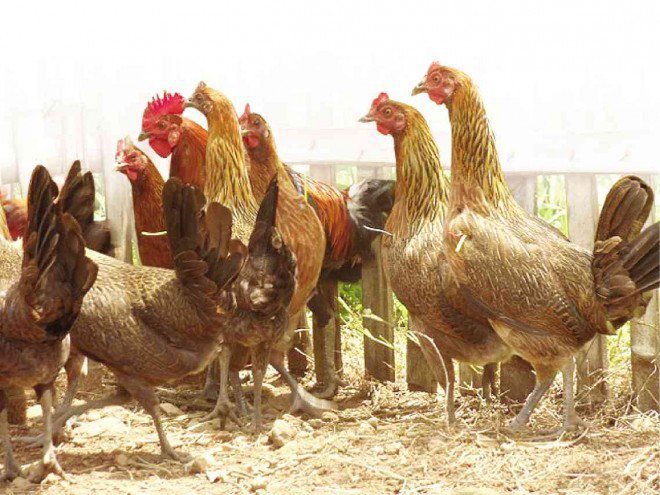Benefits of Rearing Darag Native Chickens in the Philippines
Benefits of Rearing Darag Native Chickens in the Philippines
Along Parawakan chickens, Darag chickens are some of the most popular native chicken breeds among Filipinos that want to go into the native chicken farming business. Similarly, they are also popular among people that want to start a free range chicken farming venture in the Philippines.
In this article, we take a look at all of the things that you need to know when considering raising Darag chickens – ranging from what their defining characteristics are, through the advantages and disadvantages of rearing them, all the way to their commercialization potential.
What Are Darag Native Chickens?
Having evolved from the Red Jungle fowl (Gallus gallus bankiva), darag chickens are indigenous to – and still can be found mostly in – the Western Visayas region of the Philippines.
Some of the defining characteristics of this strain of chickens include a single comb, a whiteish earlobe, and a gray shank. Furthermore, the female chickens – oftentimes simply referred to as “Darag” – are typically yellowish-brown color. And, the males – or simply “Alimbuyog” or “Labuyo” – typically have black feather and tail, and red wings and hackle.
In terms of their weight, while females average 1 kilogram when they reach adulthood, males average about 1.3 kilogram.
Advantages of Rearing Darag Native Chickens
While there are some disadvantages to farming Darag native chickens instead of the various commercial varieties – some of which we will look at in the next section – there are also many advantages working in favor of the native breed.
Perhaps the very first advantage that should be mentioned here is the fact that over the years as commercial varieties took over the market, Filipinos started craving the taste of the traditional Darag chicken. As such, a fairly sizable niche market for Darag chicken products has formed.
One of the reasons that the native chicken are regaining their popularity in the Philippines is the fact that they have a unique, and arguably better, taste as compared to the commercial varieties. That applies to both their meat and their eggs.
The above, as well as the fact that the products made out of Darag native chickens have better nutritional composition is largely a result of the fact that while the commercial breeds are often raised indoors with high stocking density and fed with regular formulated diet, the native chickens are raised in free range – and often organic – conditions.
That in turn means that rather than eating formulated diet, they are exposed to natural nutrients such as grubs, worms, legumes, grass, and so on.
And, because of all of this, the customers that buy Darag chicken products can be sure that instead of being full of chemicals, antibiotics, and other elements that might help speed up the production but lower the quality of the product, the chickens are full of vitamins and healthy in general.
Besides the benefits above – which are largely focused on the end consumer eating the poultry products – there are also numerous benefits for the farmers.
First of all, farming native Darag chicken doesn’t require the same strict biosecurity and feeding standards as farming commercial varieties, especially as a contract farmer, would.
Second, the Darag native chickens are also lower maintenance compared to the commercial breeds. They are able to live in a natural hardy environment without any special housing or feeding requirements. Plus, the process of natural selection ensured that the Darag chickens are highly resistant to diseases. As such, they have excellent survivability and they can thrive even in the harshest environments of the Philippines where commercial breeds would rarely stand a chance.
Furthermore, because of the above, the barriers to entry into farming native chicken are much lower in spite of the fact that native chicken products can fetch good prices in the market.
The skill barrier is lower since the birds are not as difficult to raise as the commercial breeds (get our guide to learn all the necessary basics), and the financial barrier is lower as well since the there is no necessity to build elaborate chicken houses and buy expensive poultry feed.
Finally, because of the uniqueness of the Darag native chickens, it is hard to replicate their taste and quality in commercial conditions. That ensures that the native chicken farmers will have a constant stream of demand, since there will always be people preferring the taste and quality of this breed.
Production Characteristics and Cycle of Darag Native Chickens
Since they are birds that evolved naturally rather than birds that got engineered by major poultry companies, the birds generally don’t have excellent production characteristics like their exotic counterparts. That is not a big issue on the smaller scale, but if you plan to scale your native chicken farming into a larger venture, it could pose you with challenges.
The biggest disadvantage of farming native chicken is the difficulty of getting consistent results in terms of production cycles, egg sizes and colors, and meat amount. In general, however, your farming cycle will be very similar to the below.
The mature Darag chickens will lay eggs – although not as prolifically as commercial layers. But, the eggs will be full of nutrients and will taste great. As for the small chicks, they will be in brooding period during the first three weeks of their life.
Once they are through the brooding period, they can be – and often are – taken through a hardening process which helps improve their livability and makes them resistant to diseases and environmental extremities. This process involves exposing the chickens to rugged conditions under which they naturally thrive and grow, and it takes place roughly until the seventh week of their life.
With the hardening process over, the chickens become ready to take care of themselves in free range and semi-free range environments, foraging for their own food and developing their own survival mechanisms against predators, harsh temperatures, and other challenging things.
The chicken will mature anywhere between the eleventh and the eighteenth week of their life depending on what environment they grow in, and at that point they will be ready for slaughter. Depending on the farmer’s preferences, they might even be raised a bit longer.
For more information about raising Darag and other native chickens, make sure to check our Native Chicken Farming in the Philippines guide.
Commercialization of the Darag Chicken
While, as mentioned above, the Darag chickens are not perfectly suitable for commercial production, there are still ways to produce enough of Darag products for a sizable business. We will introduce you to some of the methods that farmers use to scale their production of Darag chickens below.
One of the keys to succeeding with commercial production of Darags is the “hardening” phase mentioned in the above section.
During the “hardening” phase, chicks are separated from mother or removed from brooder and fed on a formulated diet and other diets until they are about 45 days old. While they can be started to get introduced to a free range system here, in this phase they should still be in a tightly controlled environment. Then, after 45 days, they can be united with the rest of the Darag flock in natural conditions.
Also, to the extent possible, you should buy Darag chickens that have been professionally bred and brooded by a reputable seller. That way, you can ensure that your flock will be as standardized as possible which will lead to the maximum possible consistency in your product quality – which in turn is highly appreciated by restaurants and other buyers.
Another thing to keep in mind is that while in the beginning of the article we mentioned that the biosecurity does not have to be as strict as with commercial varieties, that does not mean it should be neglected – especially not in case you are trying to run a successful commercial venture.
Instead, the chickens should be provided by good housing and overall environment, and be raise using management practices that will minimize diseases, contamination, predation, and other various stressors that might have negative impact on yield.
And, while the chickens are generally fairly disease-resistant, they should still be vaccinated according to schedule determined with your veterinary as that will increase their survivability even further.
Finally, just as with any other business, while creating a good quality product – raising chickens that produce quality meat and eggs – is important, marketing and selling the products is equally important.
As such, you will need to adopt not only the best chicken management practices you can, but also the best possible business management practices.https://poultrymanual.com/rearing-darag-native-chickens-in-the-philippines
0 Likes1 Reply
The Future of the Darag Chicken
With their special place in the Filipino culture, there has always been an effort in the country to improve the production characteristics of and husbandry systems for Darag chickens to boost production levels and farmers’ incomes.
As part of that, for example, West Visayas State University has conducted a lot of research into how to improve the Darag chicken production systems, especially when it comes to smaller rural farmers that may not have enough resources for commercializing their production.
As mentioned above, the current recommended production mechanism involves putting the chickens through a commercial layer and broiler production system at first to “harden” them before releasing them into a free range system in which they can forage and survive like traditional Darag chickens.
However, the research is still ongoing, and there will certainly be more news coming on this front – whether it be about new methods of raising the Darag chickens or news about improved varieties of the breed.
For now, if you are interested in farming native chickens, our guide might be a helpful partner in getting your farming venture off the ground.



















